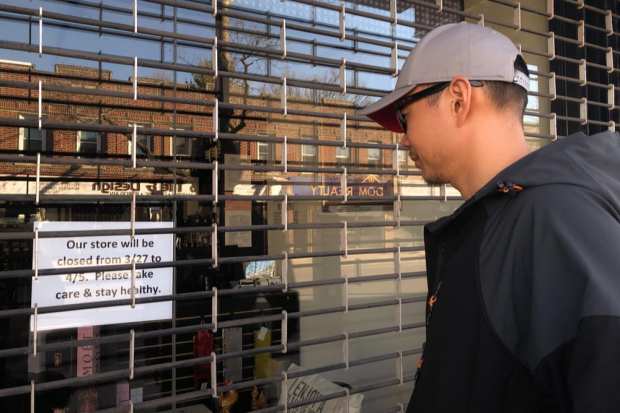Can Stimulus Funds Battle Back The Main Street Cash Crunch?

By the numbers the news is not bright this week — pretty much no matter where one looks as the coronavirus pandemic continues. Unemployment filings have had their second wrong type of record-breaking week in a row — with a staggering 6.6 million for the week that ended March 28. The consensus estimate for what the filings were going to be pre-release? About 3.8 million claims.
A big, bad surprise — but one in line with the latest edition of the PYMNTS COVID-19 briefing series, “Main Street On Lockdown: How SMBs Are Coping With The Economic Fallout Of COVID-19.” The numbers, taken from surveys of 200 small and medium-sized business (SMB) owners, are sobering. Nearly all, 89 percent, of firms we spoke to expect to generate less revenue in 2020 than they did in 2019, over a quarter (25.8 percent) do not believe their firm will survive this downturn, and an additional third (32.6 percent) are unsure if they are going to make it.
That means more than half (58.4 percent) of all U.S. SMBs are forecasting potential permanent closure as a potential result of the coronavirus pandemic, a reality, according to PYMNTS data, that seems largely driven by an unfolding cash flow crisis on Main Street U.S.A. On average the SMBs PYMNTS surveyed report having access to cash reserves sufficient to last them another 20 days. Within that average, though, there is a wide range of experience. Some, 32.4 percent to be exact, are already broke and report having no ready access to potentially needed cash. Another 30.7 percent say they have cash readily available if they need it, while the largest single share, 43.2 percent, report having cash on hand to survive the slowdown.
And cash flow strength is at present what is most positively correlated with confidence about future survival. The 87.3 percent of firms that report having access to cash also report being confident their firm will survive the downturn. But while access to funds builds confidence, it is not necessarily a guarantor of it. The data also found that the majority of both unstable and unsure firms — 62.9 percent of both to be exact — say they have cash reserves available.
Unsurprising, SMB owners are looking for relief in a variety of places — cutting overhead by laying off staff, asking for forbearance from their lenders and landlords and seeking lowered payments to vendors. They’ve also gone seeking aid from the government. As of last week about a quarter of SMB owners had applied for governmental assistance and those that actually received it enjoyed a boost in confidence about their longer-term viability — 72.2 percent of SMB owners who are confident that they will remain open have received government assistance. But so far the aid is not flowing profusely — of those who applied only 54.2 percent had actually received that aid payment.
But that might be about to change. PYMNTS most recent data come from March 24 — about three days before President Trump signed the $2T CARE Act into law. The relief package, among a host of other offerings, contains $350 million in funds for Small Business Administration (SBA) relief loans to businesses with fewer than 500 employees that were in existence by the end of January 2020. The stimulus loans have almost no underwriting requirements — businesses don’t have to demonstrate their profitability, revenue amount or likeliness to repay, largely because the loans are not designed to be repaid. Instead SMBs are allowed to borrow up to 2.5 times their monthly payroll amount and have that loan forgiven provided they keep their staff fully employed with the funds. The only documentation that needs to be submitted along with those loan applications, Dan Speight, CEO at Planters First Bancorp noted in a recent PYMNTS digital discussion with Karen Webster and Ingo Money CEO Drew Edwards, is payroll data.
“After that, then it becomes a matter of, ‘OK, we got all the information, we got your application, sign the note and here’s your money.’ I mean that’s the way it’s supposed to work. And it could be that easy,” Speight said.
Could be, but probably won’t be, Speight said, at least not at first. This stimulus loan program is unlike anything any banker has ever seen before, because unprecedented times call for unique measures. This a concept that went from virtual non-existence to applications in the field in a little under 10 days — and there are still administrative details being figured out in real time around verifying that payroll data and how exactly the loans are going to be approved.
Applications are officially open for business Friday (April 3) he noted, but despite some official predictions that payments will start rolling out the same day, a more likely scenario is for money to start pushing out sometime next week.
But the pressure is on to get the money out — the PYMNTS Main Street data and the veritable tsunami of unemployment claims that went into the books this week are testament to that. The government, Edwards noted, knows this money has to move now — and is willing to be far more flexible about risk, verification and a whole host of other subjects to make sure funds start flowing.
“The government is expecting there to be a level of fraud and they understand that, but they want to err on the side of getting people their money,” Edwards said.
Because for the 30 percent of business that have already shut their doors and the roughly 31 percent that are out of cash and without a way to access any more, the clock is ticking loudly. And if the cavalry doesn’t ride in soon with relief funds in an incredibly prompt manner, Main Street won’t be on lockdown for much longer.
It will just be vacant.
